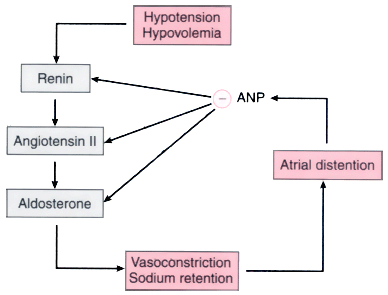 |
 |
Figure 20-19
Interactions between atrial natriuretic peptide (ANP)
and the renin-angiotensin-aldosterone system. Hypotension or hypovolemia triggers
the release of renin from the afferent arteriole, thereby causing the formation of
angiotensin II, which stimulates the release of aldosterone from the adrenal cortex.
Angiotensin II and aldosterone cause vasoconstriction and sodium retention, ultimately
resulting in re-expansion of intravascular volume; this volume re-expansion causes
atrial distention, which triggers the release of ANP. ANP inhibits the release of
renin, renin's action on angiotensinogen to form angiotensin II, angiotensin-induced
vasoconstriction, stimulation of aldosterone secretion by angiotensin II, and the
action of aldosterone on the collecting duct. Thus, the actions of ANP promote vasodilation
and sodium excretion. Therapeutic administration of fluids to distend the atrium
and release ANP is an important intervention to curtail renal vasoconstriction and
sodium retention.

 |
